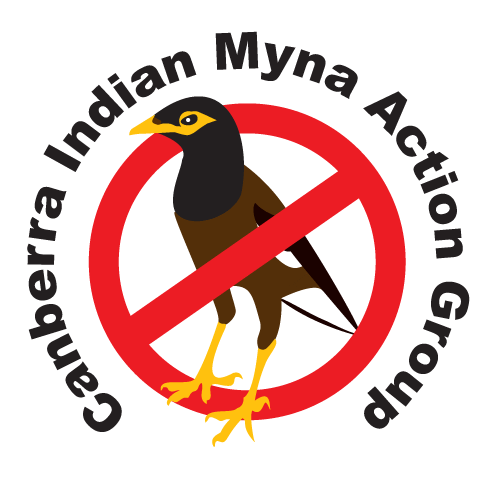Protocol on Animal Welfare
The Canberra Indian Myna Action Group Inc. (CIMAG) has the aim of protecting native birds and other wildlife from the threat posed by the Indian Myna (also called the Common Myna), as well as to reduce the loss of public amenity that they cause.
Part of its strategy is a humane reduction program through trapping and euthanising mynas.
Members of CIMAG who participate in this part of the strategy are required to adopt the following animal welfare protocol.
Management of Traps
- Traps used are to be designed specifically for Indian Mynas (or Starlings) that avoid trapping native birds.
- Trappers are not to use seed or seed-based food (eg bread) in traps – this can attract native birds
– use dry dog food for small adult dogs or cat food as the bait
– if a native bird is trapped, it is to be released immediately (avoid letting mynas escape) - do this by placing a rag over the door opening and putting your hand underneath the rag and grab the non-target bird. This stops mynas from escaping as you are catching the other bird.
- The traps are to contain food and clean water for any trapped birds.
- Traps are to be checked morning and evening.
- The birds are not to be exposed to undue stress while trapped — AVOID APPROACHING THE TRAP DURING DAYTME HOURS: this avoids scaring them, and also mynas associating humans with traps and then becoming trap shy.
- Trapped Indian Mynas (and Starlings) are to be disposed of in a reasonable period (within two days), rather than kept captive for days on end.
- If decoy birds are used in traps, they and any trapped birds are to have access to adequate food, clean water, shelter and shade.
- The birds are not to be treated cruelly: observe the requirements of the Animal Welfare Act 1992 and see RSPCA policy: RSPCA Policy – Management of Wild Animals
Dealing with Trapped Birds
The method used for disposing of trapped birds is to be quick, painless, and stress-free.
Acceptable euthanising methods include gassing with carbon dioxide or carbon monoxide.
- if using carbon monoxide, you must use a car with a cold engine: do not use diesel vehicles
- place the containment chamber with the trapped birds in a near-airtight bag or box, connect a grey water hose / pipe from the car exhaust pipe into the bag / box and run the cold car for 1½ minutes or so, walk away for a further minute while the gas settles: the birds should be unconscious within 10-15 seconds and dead within 30-40 seconds. If it takes longer than 30-40 seconds for the birds to die peacefully there is something wrong with your technique, and you should contact CIMAG for advice.
We prefer that cervical dislocation (breaking their necks) is not used, except by qualified professionals and then is to be instantaneous, with minimal handling of the birds. Our preference is that trappers do not adopt this method as it is stressful to the birds in the trap, unpleasant and can allow birds to escape.
Disposal of Dead Birds
Dead birds are to be disposed of in a hygienic and environmentally sound way, as per CIMAG advice.
